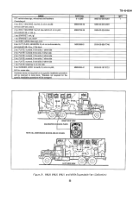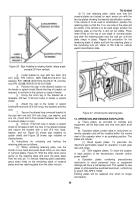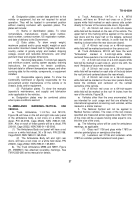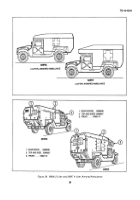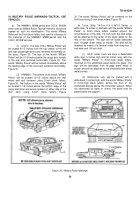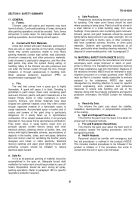TB-43-0209 - Page 38 of 406
TB 43-0209
c.
Ventilation
.
The use of respiratory protection equipment does NOT
waive the requirement for engineering control measures.
The ventilation design specifications for spray paint
booths are in TB MED 514.
d.
Preferred Paints
.
Whenever possible, Type II or Type III aliphatic
polyurethane paints (PUP) should be substituted for
Type I since they contain no lead or chromate. Non-lead-
containing primers should be used when available.
e.
Warning Labels
.
Warning labels are required on products containing lead
or chromium IV.
20. MEDICAL
SURVEILLANCE
General.
Medical
surveillance to detect adverse health effects will be
determined by the installation medical authority (IMA)
based on the specific constituents of the coating. In
general, medical surveillance is required for anyone who
works more than 30 days per year in either a paint
spraying operation or in a brush or roller application
when respiratory protection is required. Personnel
involved in painting at direct support, general support,
and depot levels of maintenance will normally require
surveillance. Vehicle/equipment operators and unit
maintenance section personnel usually do not perform
enough brush touchup painting to warrant medical
surveillance.
21. DISPOSAL
a.
General
.
Unserviceablepaints including aliphatic polyurethane
paint (PUP)/epoxy polyamide enamel (EPE) blend must
be discarded as a hazardous waste according to AR
420-47. Note that because they contain ignitable
solvents, these unusable blends of PUP are defined as
hazardous wastes by the Resource Conservation and
Recovery Act (RCRA) of 1976 as amended by the
Hazardous and Solid Waste Amendments of 1984.
Unserviceable component B is a hazardous waste per
RCRA due to ignitable solvent content; not because it
contains HDI.
b.
Method of Disposal
.
The method used to dispose of this waste stream
depends on the types of paint used. When the paints
contain no hazardous heavy metals, the liquid portion of
the waste stream may be able to be discharged into the
sanitary sewer and the sludge disposed of in a sanitary
landfill. The environmental coordinator should be
contacted to ensure state and local ordinances are not
violated. If heavy metal-based paints have been used,
samples of the liquid and sludge should be analyzed for
the characteristic of extraction procedure (EP) toxicity
(heavy metals) and disposed of accordingly.
(1) If a sanitary sewer serving a paint processing
operation discharges to a government-operated sewage
treatment plant (STP), notify the STP operator of the
approximate additional loadings of total organic carbon,
biochemical oxygen demand, and total processing
operation prior to discharge.
(2) If a sanitary sewer serving a paint processing
operation discharges to privately owned treatment works,
pretreatment of wastewaters may be required by local
regulatory authority.
The installation environmental
coordinator should determine such cases with public
environmental
regulators
having
primacy
over
government installations. Pretreatment regulations have
been summarized by the USAEHE Water Quality
Information Paper No. 13.
22. SPECIFIC HAZARDS
a.
Temperature
.
CAUTION
•
Coatings should not be applied at temperatures
below 50'F (10°C) as they will not cure properly.
b.
Equipment Hazards
.
CAUTION
•
Mask intake and exhaust parts, breathers, etc.,
carefully to prevent dust, solution, water, or
metal conditioner from entering the engines of
vehicles.
•
Do not use solvents on electronic equipment as
they may cause changes in performance.
•
Do not use petroleum based products on natural
rubber as they are destructive agents.
•
Do not use spray equipment containing any
aluminum
components
to
apply
coatings
formulated with 1,1,1 trichloroethane (such as
MIL-C-46168,
Type m).
23. OTHER PUBLICATIONS
Additional safety information is contained in the
following publications:
a.
AR 40-5, Preventive Medicine.
b.
CFR 1910, OSHA Safety and Health Standards.
c.
DODI
4145.19-R-1,
Hazardous
Materials
Handling and Storage Criteria.
d.
TB MED 502, Occupational and Environmental
Health Respiratory Protection Program.
33
Back to Top

